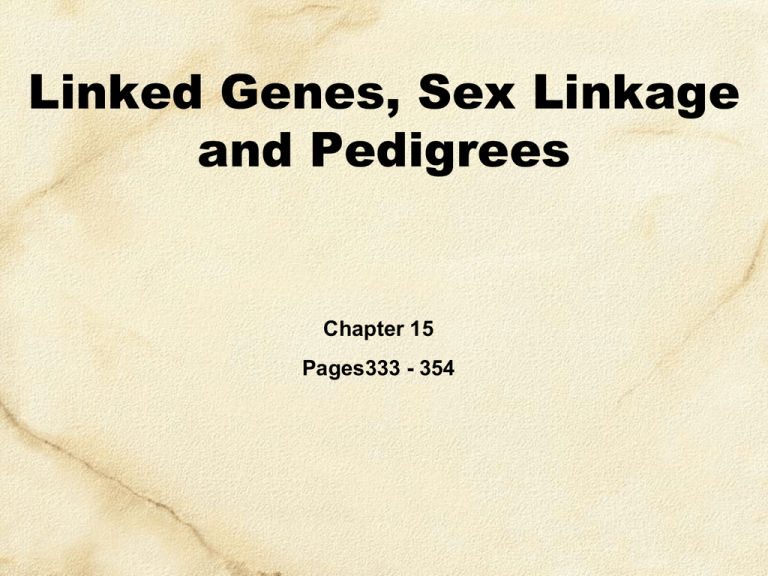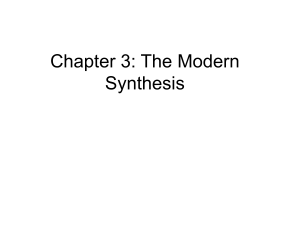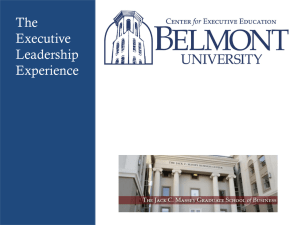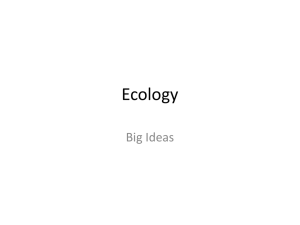
Linked Genes, Sex Linkage
and Pedigrees
Chapter 15
Pages333 - 354
Linked Genes 1
Genes on the same chromosome
are said to be linked. They are
inherited together as a unit and do
not undergo independent
assortment.
One homologous pair
of chromosomes
Oocyte
Linkage can alter expected
genotype and phenotype ratios in
the offspring.
In this example, only two types of
gamete are produced instead of
the expected four kinds if the genes
were assorted independently.
Gametes
Meiosis
Ab
Ab
aB
Genes A and B control different traits and are
on the same chromosome
aB
Linked Genes 2
Genes located on the same
chromosome are said to be
linked (e.g. genes A and B).
Linked genes tend to be
inherited together.
Linkage results in fewer
genetic combinations of alleles
in offspring (compared to
genes on separate
chromosomes).
Parent 1 (2N)
AB
ab
Parent 2 (2N)
Linked
Linked
Two genes are linked
when they are on the
same chromosome
ab
ab
Line
indicates
linkage
Chromosome
pair before
replication
In describing linkage, the
appropriate notation shows a
horizontal line separating
linkage groups.
Chromosomes after replication
Linked Genes 3
Chromosome
s after
replication
X
The inheritance patterns
involving linked genes do
not follow expected
Mendelian ratios.
Meiosis
Gametes (N)
Only one
gamete from
each replicated
chromosome is
shown
In this example of linked
genes, only two kinds of
genotype combinations
occur in the offspring.
Without linkage, the same
parents would provide four
possible genotypes:
AaBb, Aabb, aaBb, aabb.
AaBb
AaBb
aabb
Possible
offspring
Only two
genotype
aabb combinations
occur
Recombination
Parent 1 (2N)
Parent 2 (2N)
Recombination refers to the exchange
AB
of alleles between homologous
ab
chromosomes as a result of crossing
over between linked genes.
Before replication
After replication
X
Crossing over
has occurred
Meiosis
AB
Ab
aB
ab
ab
ab
ab
ab
Gametes (N)
Recombination between alleles
of parental linkage groups is
indicated by the appearance of
recombinants in the offspring,
although not in the proportions
that would be expected with
independent assortment.
Linked
genes
Offspring
Recombination results in new
combinations of parental
characteristics in the offspring.
These offspring are called
recombinants.
ab
ab
AaBb
aabb
Non-recombinant
offspring
Aabb
aaBb
Recombinant
offspring
Autosomal & Sex-Linked Genes
Genes on one or other of
the sex chromosomes
produce inheritance
patterns different from
that shown by
autosomes:
Autosomal Genes
Sex-Linked Genes
1. All individuals
carry two
alleles of each
gene
1. Males carry only
one allele
of each gene
(hemizygous)
2. Dominance
operates in
both males and
females
2. Dominance
operates in
females only.
3. Reciprocal
crosses
produce the
same results
4. Alleles passed
equally to
male and female
offspring
3. Reciprocal crosses
produce
different results.
4. ‘Criss-cross’
inheritance
pattern: father to
daughter to
grandson, etc
Sex Linkage
Sex linkage refers to the phenotypic
expression of an allele that is
dependent on the sex of the
individual and is directly tied to the
sex chromosomes.
Most sex linked genes are present on
the X chromosome (X-linkage) and
have no corresponding allele on the
smaller male chromosome.
In some cases, a phenotypic trait is
determined by an allele on the Y
chromosome. Because the Y
chromosome is small and does not
contain many genes, few traits are Ylinked and Y-linked diseases are rare.
X
Y
Note the size differences
between the X and Y
chromosomes. The Y lacks
alleles for many of the genes
present on the X.
Sex Linkage
Sex-linked traits show a
distinct pattern of inheritance.
Unaffec
ted
father
Fathers pass sex-linked
alleles to all their
daughters but not to their
sons.
X
Mothers can pass sexlinked alleles to both sons
and daughters.
In females, sex-linked
recessive traits will be
expressed only in the
homozygous condition.
XY
Carri
er
moth
er
Y
X
XX
X
XX
XY
In contrast, any male
receiving the recessive
allele from his mother will
express the trait.
Unaffec
ted son
Unaffec
ted
Carrier
daught
Affecte
d son
Pedigree Analysis
Pedigree analysis is a way of illustrating inheritance patterns. It is a good
way to follow the inheritance of genetic disorders through generations.
Symbols are used to
represent males, females
etc. For traits of interest,
symbols can be shaded to
indicate individuals carrying
the trait.
Individuals are designated
by their generation number
and then their order number
in that generation.
Normal female
Affected male
Died in
Sex
infancy
unknown
Affected
Normal male
female
NonIdentic
identical
al
twins
twins
Carrier
(heterozyg
ote)
I, II, III
Generati
ons
1, 2, 3Children (in birth
order)
Sex Linked Recessive
Inheritance
For a recessive trait controlled
by a gene on the X
chromosome, the features of
inheritance can be illustrated
with the standard symbols
used on pedigree charts. Note
that:
More males than females
express the trait.
Carrier females do not show
the trait but pass it to sons.
All daughters of affected
males will at least be
carriers of the trait.
Unaffected
female
Affected male
Carrier
Famously, Queen
Victoria was a carrier
of the allele for
hemophilia, passing
it to one of her sons
and, through her
daughters, to the
royal families of
Prussia, Russia, and
Spain.
Sex Linked Dominant Inheritance
Sex-linked dominant
inheritance is rarer
because all daughters of
affected males will be
affected (the
heterozygous condition is
not a carrier).
Unaffected
female
Sex-linked dominant traits
are never passed from
father to son.
Affected females produce
50% normal and 50%
affected offspring.
Some X-linked dominant conditions, such as
Aicardi syndrome, are lethal to boys. They are
usually seen only in girls but may be seen in
males with Klinefelter syndrome (XXY)
Affected male
Sex Linkage in Humans
A rare form of rickets in humans is a sex-linked dominant trait. It is
determined by a dominant allele of a gene on the X chromosome.
This condition is not treatable with vitamin D therapy.
A typical inheritance pattern is shown. XR indicates affected by rickets.
Genetic Counseling
In the example of the
sex-linked dominant
form of rickets, the
ratios of affected
children can be
determined if the
phenotype and
genotype of each
parent is known.
In this case, the
prospective parents
would be advised
that there is a 50%
chance of having
an affected child.
Only girls would be
at risk.
Nor
mal
wom
Parents
an
X
Gametes
X
XX
X
XRY
XR
Affect
ed
male
Y
Possible
fertilizatio
ns
Children XXR
Affect
ed
femal
e
XY
XXR
XY
Nor
mal
male
Affect
ed
femal
e
Nor
mal
male
Autosomal Dominant Disorders
These are inherited disorders caused by dominant alleles on
autosomes. Dominant conditions are evident both in
heterozygotes and in homozygous dominant individuals.
Examples include:
Huntington disease
•
Autosomal Dominant Pattern
An idealised pattern of
inheritance of an autosomal
dominant trait includes the
following features:
both males and females
can be affected
all affected individuals have
at least one affected parent
transmission can be from
fathers to daughters and
sons, or from mothers to
daughters and sons
once the trait disappears
from a branch of the
pedigree, it does not
reappear
in a large sample,
approximately equal
numbers of each sex will
be affected.
•
•
•
•
•
Autosomal Recessive Disorders
Inherited disorders caused by recessive alleles on autosomes. Recessive
conditions are evident only in homozygous recessive genotypes. Eg.
Cystic fibrosis.
The trait is not sex linked and is shown by both males and females. The affected
female in the third generation has phenotypically normal parents.
All generation II offspring
are carriers for the albino
allele.
III-2 is an albino girl whose
paternal grandmother and
maternal grandfather are
also albinos.
All her other relatives are
phenotypically normal.
(Photo: UK Cystic Fibrosis Gene Therapy Consortium)
The pedigree for albinism (lack of pigment in the hair, skin and eyes) is inherited
as an autosomal recessive trait.
• An
idealised pattern of inheritance of an autosomal
recessive trait includes the following features:
• both males and females can be affected
• two unaffected parents can have an affected child
• all
the children of two persons with the condition must
also show the condition
• the
trait may disappear from a branch of the pedigree,
but reappear in later generations
• over
a large number of pedigrees, there are
approximately equal numbers of affected females and
males.
Inheritance of X-Linked
Recessive Traits
Hemophilia is an X-linked disorder in which blood clotting time is
prolonged.
Women who are heterozygotes are carriers for the recessive allele but do
not have hemophilia. They can pass the allele to their sons (XY) who will
express the recessive allele and have hemophilia.
In the first generation, the female
of the affected family is a carrier
for the hemophilia allele.
Two of the offspring of the affected
family also carry the allele; the male
is affected and the female is a carrier.
Offspring of the female carrier and
an unaffected male can be unaffected,
carrier females, or affected males.
X linked Recessive Pattern
•
An idealised pattern of inheritance of an Xlinked recessive trait includes the following
features:
•
•
•
•
•
all the sons of a female with the trait are
affected
all the daughters of a male with the trait will
be carriers of the trait and will not show the
trait; the trait can appear in their sons
none of the sons of a male with the trait
and an unaffected female will show the
trait, unless the mother is a carrier
all children of two individuals with the trait
will also show the trait
in a large sample, more males than
females show the trait.
Inheritance of X-Linked
Dominant Traits
In this rare pattern of inheritance, all the daughters of affected males
will be affected and more females than males will show the trait.
An affected male must always have an affected mother.
The inheritance of a rare
form of rickets follows this
inheritance pattern.
The male I-2 is affected and all
his daughters II-2, II-3, and II-4
are affected.
The affected female II-4 can
produce affected offspring of
both sexes (III-2, III-3).
X linked Dominant Pattern
•
An idealised pattern of inheritance of an X-linked
dominant trait includes the following features:
•
a male with the trait passes it on to all his daughters
and none of his sons
•
a female with the trait may pass it on to both her
daughters and her sons
•
every affected person has at least one parent with the
trait
•
if the trait disappears from a branch of the pedigree, it
does not reappear
•
over a large number of pedigrees, there are more
affected females than males
Examples include:
Vitamin D
resistant rickets
Y-linkage
• The Y chromosome has fewer genes and most are involved in male sex
determination and fertility.
• So there are fewer Y-linked genetic disorders.
• Y-linked conditions:
- Hairy ears
-
Azoospermia – almost
nil sperm
Is the condition observed in each generation of a family in which it occurs?
NO
YES
If daughters have the
condition does their
father also have it?
NO
Autosomal
recessive
Do males with the
condition who mate
with a normal female
have all daughters,
but no sons with the
condition?
ON
Is the condition
mainly in males?
Do only males have
condition, passing it
from father to son?
NO
YES
Sex-linked
recessive
Autosomal
dominant
YES
Sex-linked
dominant
YES
Y linkage
Types of variation
• Genetic traits influenced by a single gene usually only have
two or three possible phenotypes.
(EG. Positive or negative blood factor, right or left handed, ear
lobe shape, dimpled chin, hand clasp)
• The population is said to show discontinuous variation for the
1.2
trait.
Rh factor
1
• Data would look like this graph
no in-between variations
0.8
0.6
% of
population
0.4
0.2
0
just one or the other.
2
• Discontinuous variation can be influenced by more than one
gene.
• For example in budgerigars feather colour is influenced by
three genes that produce seven colours.
• Each colour is distinguishable from the others so they are still
discontinuously variable.
35
Feather colour in Budgerigars
30
25
% of
population
20
15
10
5
0
2
3
4
5
6
7
• When a large number of genes (called polygenic) influence a
phenotype then the population will show continuous
variation.
• Individual phenotypes are impossible to distinguish.
• Examples:
Height
35
- Height and mass in humans.
30
25
- Milk production in cows. % of
population
20
15
10
5
0










